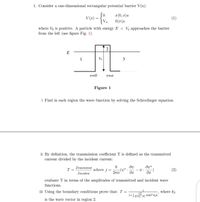Question

Transcribed Image Text:1. Consider a one-dimensional rectangular potential barrier V(x):
z(0, r)a
0(r(a
V(x) -
(1)
where Vo is positive. A particle with energy E < V, approaches the barrier
from the left (see figure Fig. 1).
2
E
1
3
x=0
x=a
Figure 1
i Find in each region the wave function by solving the Schrodinger equation.
ii By definition, the transmission coefficient T is defined as the transmitted
current divided by the incident current:
T- İranamtted
Jimetdent
where j
2mi
(2)
evaluate T in terms of the amplitudes of transmitted and incident wave
functions.
iii Using the boundary conditions prove that: T =
where k2
1+E Ninh? kga
is the wave vector in region 2.
Expert Solution
This question has been solved!
Explore an expertly crafted, step-by-step solution for a thorough understanding of key concepts.
This is a popular solution
Trending nowThis is a popular solution!
Step by stepSolved in 7 steps with 15 images

Knowledge Booster
Similar questions
- There is an electron, in a 1-d, infinitely deep square potential well with a width of d. If it is in ground state, 1. Draw the electron's wavefunction. Show the position of the walls of the potential well. 2. Explain how the probability distribution for detecting the electron at a given position differs from the wavefunction.arrow_forward1.The odd parity eigenstates of the infinte square well , with potential V = 0 in the range −L/2 ≤ ? ≤ L/2, are given by : (see figure) and have Ψn(x, t) = 0 elsewhere , for n=2 , 4 , 6 etc a) Sketch the potential of this system , including in your sketch the positions of the lowest three energy levels . Indicate in your sketch the form of the wavefunction for a particle in each of these energy levels , and state which of the wavefunctions you have drawn could be decirbed by the Ψn written above (see figure) . b) Calculate the expectation value of momentum , ⟨p⟩ for a particle with n=2 c) Calculate the expectation value of momentum squared ⟨p 2⟩ , for a particle with n = 2 . Hint : you may use the mathematical identiy sin2 x = 1/2 (1 − cos 2x) without proof .arrow_forward